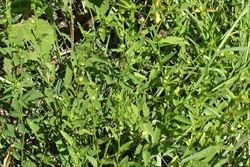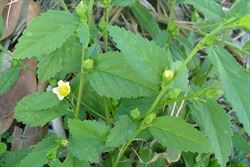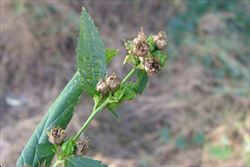Click on images to enlarge

infestation (Photo: Sheldon Navie)

upright habit with narrow leaves (Photo: Chris Gardiner)

spreading habit with broader leaves (Photo: Sheldon Navie)

relatively broad lower leaves with toothed margins (Photo: Sheldon Navie)

upper leaves and flowers (Photo: Sheldon Navie)

close-up of broader lower leaves and flower buds borne on short stalks (Photo: Sheldon Navie)

narrow upper leaves and flower buds (Photo: Chris Gardiner)

close-up of flower (Photo: Sheldon Navie)

immature and mature fruit, sometimes in clusters in the upper leaf forks (Photo: Sheldon Navie)

close-up of immature fruit (Photo: Sheldon Navie)

close-up of mature fruit (Photo: Sheldon Navie)

close-up of 'seeds', each with two spiny awns (Photo: Sheldon Navie)
Scientific Name
Sida acuta Burm. f.
Synonyms
Sida acuta Burm. f. subsp. carpinifolia (L.f.) Borss. Waalk.Sida carpinifolia L. f.
Family
Malvaceae
Common Names
broom grass, broom weed, broomweed, cheese weed, cheeseweed, clock plant, common fanpetals, common wireweed, morning mallow, sida, southern sida, spiny-head sida, spinyhead sida, spiny-headed sida
Origin
This species may have originated in Central America, but it is now widespread throughout the tropical and sub-tropical regions of the world (i.e. pan-tropical).
Naturalised Distribution
Widely naturalised throughout the northern parts of Australia. It is most common in the coastal regions of central and northern Queensland and in the northern parts of the Northern Territory. Relatively common throughout the northern regions of Western Australia and other parts of northern Queensland. Also recorded in other parts of the Northern Territory, in south-eastern Queensland, in the coastal central districts of New South Wales and on several offshore islands (i.e. Norfolk Island, Christmas Island and the Cocos Islands).
Widely naturalised overseas, including in eastern Asia (i.e. China and Taiwan) and on several Pacific islands (e.g. the Galápagos Islands, the Chuuk Islands, Fiji, French Polynesia, Guam, Hawaii, Kiribati, the Marshall Islands, Nauru, New Caledonia, Niue, Palau and the Solomon Islands).
Habitat
A weed of tropical, semi-arid and occasionally also sub-tropical and warmer temperate regions. It invades open woodlands, pastures, waterways (i.e. riparian vegetation), plantations, crops, gardens, disturbed sites, roadsides and waste areas.
Habit
A long-lived (i.e. perennial) herbaceous plant or small shrub (i.e. sub-shrub) usually growing 30-100 cm tall, but occasionally reaching up to 1.5 m in height. However, it often behaves as a short-lived (i.e. annual) plant in the wet-dry savannas of northern Australia.
Distinguishing Features
- a long-lived herbaceous plant or small shrub growing 30-150 cm tall with slender, but tough, stems.
- its yellowish-green leaves are usually elongated in shape with toothed margins and sharply pointed tips.
- its flowers (1-2 cm across) are borne singly or in small clusters in the leaf forks on short stalks.
- these flowers have five yellow petals (6-9 mm long) and five sepals.
- its fruit (2-6 mm across) break up into 5-8 wedge-shaped segments when mature.
- these one-seeded segments are topped with two sharp spines (0.5-1.5 mm long).
Stems and Leaves
The slender, yet wiry or slightly woody, stems are branched and either upright (i.e. erect) or spreading (i.e. ascending) in nature. They are sparsely covered with fine, star-shaped (i.e. stellate), hairs.
The leaves are alternately arranged along the stems and borne on short, hairy (i.e. pubescent) stalks (i.e. petioles) 3-7 mm long. These yellowish-green coloured leaves (12-95 mm long and 3-40 mm wide) are usually elongated in shape (i.e. lanceolate) with toothed (i.e. crenate or serrate) margins and pointed tips (i.e. acute or acuminate apices). They are hairless (i.e. glabrous) or sparsely covered in simple or star-shaped (i.e. stellate) hairs.
Flowers and Fruit
The yellow (rarely whitish) flowers (1-2 cm across) are borne singly or in small clusters in the upper leaf forks (i.e. axils). They are borne on short and slender stalks (i.e. peduncles) 2-8 mm long, that elongate up to 15 mm in fruit. Each flower has five pale yellow, yellow, or pale orange petals (6-9 mm long) and five mostly hairless sepals (5-8 mm long). These pale green sepals are fused together at the base (i.e. into a calyx tube) and have pointed tips (i.e. acute calyx lobes). The flowers also have numerous (about 100) tiny stamens, with their bases fused to each other, and an ovary topped with a style that is divided into 6-10 branches near its tip. Flowering occurs mostly during late summer, although it may occur throughout the year if conditions are favourable.
The fruit is a hard structure (i.e. schizocarp) that turns from green to dark brown as it matures. These small fruit (2-6 mm across and 3-5 mm high) break up into 5-8 one-seeded segments (i.e. mericarps) when fully mature. These 'seeds' (i.e. mericarps) are wedge-shaped (1.5-2 mm long) and topped with two sharp awns (0.5-1.5 mm long). The true seeds are inside these mericarps, they are smaller (about 1.5 mm long) and reddish-brown to black in colour.
Reproduction and Dispersal
This species reproduces by seed, which readily attach to animals, clothing and other materials. Seeds may also be dispersed in mud and contaminated agricultural produce.
Environmental Impact
Spiny-head sida (Sida acuta) is regarded as an environmental weed in northern Australia (i.e. northern Queensland, the northern parts of the Northern Territory and northern Western Australia).
Legislation
This species is declared under legislation in the following states and territories:
- Northern Territory: B - spread to be controlled (throughout all of the Territory), and C - not to be introduced to the Territory.
- Western Australia: P1 - trade, sale or movement into the state prevented (for all that part of the State north of the 26th parallel of latitude).
Management
For information on the management of this species see the following resources:
- the Northern Territory Department of Natural Resources, Environment and The Arts Agnote on this species, which is available online at http://www.nt.gov.au/weeds.
- the Western Australian Department of Agriculture and Food information page on this species, at http://www.agric.wa.gov.au.
Similar Species
Spinyhead sida (Sida acuta) can be confused with spiny sida (Sida spinosa), common sida (Sida rhombifolia), flannel weed (Sida cordifolia), spiked sida (Sida subspicata), spiked malvastrum (Malvastrum americanum) and prickly malvastrum (Malvastrum coromandelianum). These species can be differentiated by the following differences:
- spinyhead sida (Sida acuta) has elongated (i.e. lanceolate) leaves that are hairless or sparsely hairy on both surfaces and have pointed tips (i.e. acute apices). Its flowers are borne singly or in small clusters on short stalks (2-8 mm long) and their sepals (i.e. calyces) are mostly hairless. The fruit break up into 5-8 wedge-shaped 'seeds' (i.e. mericarps) that are topped with two sharp awns (0.5-1.5 mm long).
- spiny sida (Sida spinosa) has elongated (i.e. lanceolate) to relatively broad (i.e. ovate) leaves that are sparsely hairy above and densely hairy on their undersides with blunt or pointed tips (i.e. acute apices). Its flowers are borne singly or in small clusters on relatively short stalks (3-15 mm long) and their sepals (i.e. calyces) are finely hairy. The fruit usually break up into 5 wedge-shaped 'seeds' (i.e. mericarps) that are topped with two sharp awns (about 1 mm long).
- flannel weed (Sida cordifolia) has broad or heart-shaped (i.e. cordate) leaves that are densely covered in small whitish coloured hairs (on both surfaces) that give them a felty texture. These leaves usually have rounded tips (i.e. obtuse apices) or taper to a blunt point. Its flowers are borne in small, dense, clusters on short stalks (2-4 mm long) and their sepals (i.e. calyces) are densely hairy. The fruit break up into 8-10 wedge-shaped 'seeds' (i.e. mericaprs) that are topped with two long slender awns (2.5-3.5 mm long).
- common sida (Sida rhombifolia) has oval (i.e. elliptic), lance-shaped (i.e. lanceolate) or somewhat diamond-shaped (i.e. rhomboid) leaves with a dense covering of hairs on their undersides and a sparse covering of hairs on their upper surfaces. These leaves usually have rounded tips (i.e. obtuse apices). Its flowers are borne singly on long and thin stalks (10-40 mm long) and their sepals (i.e. calyces) are sparsely hairy. The fruit usually break up into 8-12 wedge-shaped 'seeds' (i.e. mericarps) that are topped with two awns (0.5-1 mm long).
- spiked sida (Sida subspicata) has relatively narrow (i.e. lanceolate) to broad (i.e. ovate or oblong) leaves with a dense covering of hairs on both surfaces (but more so underneath). These leaves have pointed or rounded tips (i.e. acute or obtuse apices). Its flowers are almost stalkless and borne in elongated clusters (i.e. spikes) with a few small leaves sometimes interspersed between them. Their sepals (i.e. calyces) are finely hairy and the fruit break up into 4-6 wedge-shaped 'seeds' (i.e. mericarps) that have rounded tips.
- spiked malvastrum (Malvastrum americanum) has relatively narrow or broad (i.e. elliptic or ovate) leaves with a relatively dense covering of hairs on their lower surfaces and blunt or pointed tips (i.e. obtuse or acute apices). Its flowers are borne in short, dense, clusters (i.e. spikes) that are subtended by leafy bracts and their sepals (i.e. calyces) are hairy. The fruit usually break up into 8-12 wedge-shaped 'seeds' (i.e. mericarps) that have rounded tips.
- prickly malvastrum (Malvastrum coromandelianum) has broad (i.e. elliptic or ovate) leaves with a corrugated appearance and only a sparse covering of hairs. These leaves have blunt or pointed tips (i.e. obtuse or acute apices). Its flowers are borne singly on short stalks (2-5 mm long) and their sepals (i.e. calyces) are hairy. The fruit break up into 8-14 wedge-shaped 'seeds' (i.e. mericarps) that are topped with three sharp awns (0.5-1 mm long).

